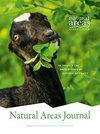白尾鹿(Odocoileus virginianus)被北美海狸(Castor canadensis)排挤和砍伐的城市自然林区天然林更新变化
IF 0.8
4区 环境科学与生态学
Q4 ECOLOGY
引用次数: 0
摘要
摘要:我们研究了宾夕法尼亚州费城Cobbs Creek公园Good Woods的城市自然区域森林在设置隔离围栏以防止白尾鹿(Odocoileus virginianus)的觅食和北美海狸(Castor canadensis)的意外砍伐后的自然更新变化。幼苗(茎径< 2.5 cm,树桩15 cm < 3.0 cm)、树苗(茎径2.5 ~ 10 cm,树桩15 cm ~ 11 cm)和乔木(茎径10 cm ~ 10 cm,树桩15 cm ~ 11 cm)在65个10 m × 10 m的永久样地进行了调查:在设置围栏以排除白尾鹿后6年,在开始采伐海狸后5个月。排除白尾鹿后,总体幼苗丰度增加了5%,树苗种群增加了20%,树数增加了34%。红枫(Acer rubrum)、郁金香白杨(Liriodendron tulipifera)和红橡树(Quercus rubra)幼苗数量显著增加,而山核桃(Carya glabra)和白蜡树(Fraxinus americana)幼苗数量显著减少。北美海狸砍伐造成的幼苗和树木损失较小(所有幼苗损失<2%,所有树木损失<3%)。然而,海狸的砍伐造成了红枫、黑樱桃(Prunus servtina)、白橡木(Quercus alba)和红橡木树苗60%以上的损失。山核桃、白蜡树和郁金香杨树的树苗损失不到30%。北美城市海狸对本地物种树苗的偏好与美国东部农村海狸相似。结果表明,白尾鹿隔离围栏在有效隔离北美海狸的情况下,是提高城市自然区域森林幼苗和树苗自然更新的有效管理方法。本文章由计算机程序翻译,如有差异,请以英文原文为准。
Natural Forest Regeneration Changes in an Urban Natural Area Forest with White-Tailed Deer (Odocoileus virginianus) Exclusion and Felling by North American Beaver (Castor canadensis)
ABSTRACT We examined natural regeneration changes in an urban natural area forest, the Good Woods, Cobbs Creek Park, Philadelphia, Pennsylvania, after placement of exclusion fencing to prevent white-tailed deer (Odocoileus virginianus) browsing and unplanned North American beaver (Castor canadensis) felling. Seedlings (stem dbh < 2.5 cm, stump at 15 cm < 3.0 cm), saplings (stem dbh > 2.5–10 cm, stump at 15 cm > 3.0–11 cm), and trees (stem dbh > 10 cm, stump at 15 cm > 11 cm) were surveyed in 65 permanent 10 m × 10 m plots: 6 y after fencing placement to exclude white-tailed deer and 5 mo after the start of beaver felling. Overall seedling abundance increased by 5% while sapling populations grew by 20% and the number of trees expanded by 34% after white-tailed deer exclusion. Red maple (Acer rubrum) seedlings, tulip poplar (Liriodendron tulipifera) seedlings, and red oak (Quercus rubra) saplings increased significantly while pignut hickory (Carya glabra) and white ash (Fraxinus americana) seedlings decreased significantly. Seedling and tree losses to North American beaver felling were small (<2% for all seedlings and <3% for all trees). However, beaver felling caused a greater than 60% loss of saplings for red maple, black cherry (Prunus serotina), white oak (Quercus alba), and red oak. Less than 30% of the saplings were lost for pignut hickory, white ash, and tulip poplar. Urban North American beaver preferences for native species saplings paralleled rural beaver in the eastern United States. Our results indicate white-tailed deer exclusion fencing is an effective management method for increasing natural regeneration of both seedlings and saplings in an urban natural area forest when the fencing also effectively excludes North American beaver.
求助全文
通过发布文献求助,成功后即可免费获取论文全文。
去求助
来源期刊

Natural Areas Journal
环境科学-林学
CiteScore
1.70
自引率
11.10%
发文量
50
审稿时长
>36 weeks
期刊介绍:
The Natural Areas Journal is the flagship publication of the Natural Areas Association is the leading voice in natural areas management and preservation.
The Journal features peer-reviewed original research articles on topics such as:
-Applied conservation biology-
Ecological restoration-
Natural areas management-
Ecological assessment and monitoring-
Invasive and exotic species management-
Habitat protection-
Fire ecology.
It also includes writing on conservation issues, forums, topic reviews, editorials, state and federal natural area activities and book reviews. In addition, we publish special issues on various topics.
 求助内容:
求助内容: 应助结果提醒方式:
应助结果提醒方式:


